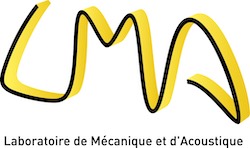Theme Auditory Perception
Research on auditory perception at the LMA aims to understand how sound signals are processed by the human auditory system. This interdisciplinary research is at the boundary of Psychoacoustics, Neuroscience, Audiology, Cognitive psychology and Acoustics.
Scientific aims
- Understand how normal-hearing and cochlear-implanted individuals perceive sounds
- Develop predictive models of auditory perception
- Improve auditory performances
Addressed studies
- Cochlear implants: Perception, electrophysiology and coding strategies : Cochlear implants (CIs) restore auditory sensations to people with severe to profound hearing loss. CIs electrically stimulate the auditory nerve fibers with an array of electrodes surgically-implanted in the cochlea. Our research aims to better understand the basic mechanisms of electrical excitation of auditory nerve fibers and to propose and test novel sound coding strategies designed to improve sound perception by CI users.
- Loudness of natural sounds : Loudness is the perceptual corollary of sound intensity. Although there are standardized models able to predict the loudness of sounds, these are mostly adapted to stationary sounds and monaural listening. Our research aims to understand and model loudness perception for non-stationary sounds in binaural listening situations.
- Perception of sound space : the ability of humans to localize a sound source in azimuth, elevation and distance is the result of complex auditory and cognitive processes and is remarkably different from one individual to another. We seek to quantify this inter-individual variability and to identify its sensory and cognitive causes. Our research also aims to evaluate the benefits of training protocols on auditory performances.
- Apart from these main studies, other research projects concern: the intelligibility of speech in noise, sound quality (acoustic comfort in vehicles, sound quality of loudspeakers), Masking, Perception at very low frequencies, sound alarms.
Contribution to socio-economical aspects
- Health : Audition, cochlear implants, aging ...
- Communication : speech perception, telephones, alarms ...
- Transports : acoustic comfort ...
Collaborations
Academic
- international :
- Medical Research Council Cambridge (United Kingdom)
- ExpORL Lab Leuven (Belgium)
- national :
- In Marseille : Hôpital de la Timone, Laboratoire de Neurosciences Intégratives et Adaptatives, Laboratoire de Neurosciences Cognitives
- In France: Institut de Recherche et de Coordination Acoustique/Musique (Paris), Laboratoire Vibrations Acoustiques de l’Institut National des Sciences Appliquées (Lyon)
Industrial partners
- Orange Labs (Lannion), Genesis (Aix-en-Provence), SNCF (Paris)











